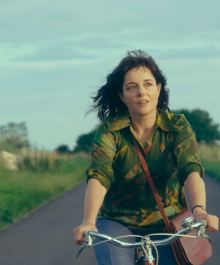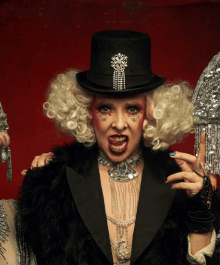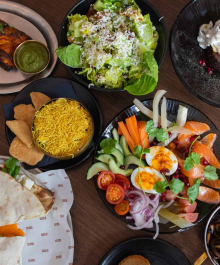

DJ Don Rogall on Vintage Rock ‘n’ Roll and Doing the Hoochie Koo
By Victoria Linchong . November 17, 2016
When Don Rogall is behind the DJ booth, it’s virtually impossible not to dance. Even if you’ve got two left feet. Even if you’re an impassive misanthrope who habitually hunches over your drink. Even if you can’t fathom anything more complicated than a pounding monotonous 4/4 beat. Don slips a 7” gem from its sleeve, places the needle gently along a track, and the speakers erupt in a gritty groove with such a gravitational pull, your head starts bobbing, your toes twitching, and then you’re hauled to your feet, riding that sweet funky rhythm. Before you know it, you’re a sweaty mess, flailing around with abandon, and then it’s suddenly dawn and you have no idea where you left your hat.
Since the 1980s, he’s played at over 200 venues in 16 countries all over Europe. And he’s not only one of Berlin’s premium purveyors of vintage rock ‘n’ roll, but he also produces albums and organizes a multitude of events, including a regular night at Bassy Club called the Hoochie Koo, where I constantly lose my hat. And a lot of other clothing. We caught up with him before the last Hoochie Koo of the year to find out what he means by, “Do the boogie, the camel twist, and lose your inhibitions.”
You have an unusually wide interest in music from electronica to R&B to Balinese chants. Is there a common thread between all the various music that you’re into? What do you listen for in a track?
I have an anthropological point of view. I like how rhythms and arrangements have a history and how that all got soaked up in the last century. Cultural roots and counterculture play a role, and this is what separates interesting musical language from pop business. Also, the most intense and interesting stuff is raw; it comes straight from the guts. I dig the work of people like Alan Lomax or Mack McCormick, but this is just the tip of the iceberg. At some point, I realized that much of the music I respond to is like a Sideshow in comparison to the Big Tent Circus. Most of it is specialized, a bit remote to some people, but with a strong oral tradition.
Oh, so that’s where your idea for the Electric Sideshow comes from. Can you tell me a little more about that? It was a music project first, wasn’t it?
Yes, I had a band called the Electric Circus Sideshow from 2006 to 2009. This was an amalgamation of many things: a passion for left field music, the strong characters of the band members, and a new artistic consciousness. The name was a bit cheeky, because we weren’t a real sideshow, but in musical terms it felt like we were just like that. It’s intriguing how in various ways, the concept of a sideshow mirrors how society and entertainment works. In early 2015, I revived the name and co-founded the Electric Sideshow with Evilyn Frantic. This time it is in fact a variety sideshow. At the moment, we are preparing for a special show during Berlin Burlesque Week in May 2017.
You’ve been DJing all over Europe since the late 1980s. How did you get your start?
I started actively buying records when I was 9 or 10. Well, I went to record stores even before then but they wouldn’t sell me anything. As a teenager, I spent all my money on records – hard earned money, too. I went to my first record fair when I was 15. The Miles Davis record I bought then is still a favorite. I read the catalogue of my preferred mail order record company like a Bible. It was also like a little Wikipedia. You got to know a lot about music just from reading it because there were notes about all the records they sold. This was before you could go online to check anything out, so it was super helpful. I compiled tapes and experimented with mixing even though I totally didn’t have the right equipment. A pair of DJ turntables was completely out of reach. So when a club asked me to jump in for another DJ, I said hell yeah. And I learned to DJ by doing it. The poor audience. But it worked pretty well, so I just continued.
Back in the 1980s and 1990s, you were playing electronic music, but now you’re mostly playing ’50s R&B. Was there some point that you decided to go back to the roots of rock & roll?
I didn’t start with electronic music. Some of the stuff I play today, I already played when I started. But I loved learning everything that a DJ can do and went through many phases. Electronically sequenced music was very convenient and fresh in the ’90s, non-durable though. Some is still relevant and I like it, but most became dispensable quickly. So going “back to the roots” was actually a step forward. I think for a DJ, ’50s and ’60s music is the most challenging but also the most rewarding. And it’s a celebration every fucking time.
What’s so challenging about ’50s music?
First of all you have to have the records and build your collection. And then, when you are DJing, everything goes in patterns. You have a certain groove that you are playing. Most DJs play a certain speed and mix everything in that tempo. But playing ’50s stuff, there are so many factors: sound quality, different rhythms, the mood, the lyrics, and the records are only two minutes long. The second you put one record on, you already have to have an idea of what you are playing next. To put these records together, to make a danceable mix, and to play the music very loud… so many things have to come together. You have to pick the groove up immediately. You have to make a plot during the set. You have to tell a story. It’s much more difficult than mixing a beat or playing instrumental techno, for example. I’m not saying that techno is a bad thing. You can also be a master DJ of techno. But playing ’50s and ’60s stuff is really challenging. A lot of people think, ‘Oh, this guy is just playing one record after another and that’s simple.’ Some people would even say that’s not DJing, that’s just playing records. But they’ve never tried it. The minute they do, they would find it’s really intense.
DJs often just barricade themselves in their booth with their collection of music. But since the mid-1990s, you’ve been experimenting with live musicians playing over the tracks you spin, essentially making live remixes on the spot. How did this idea get its start?
In ‘93, I knew a few good instrumentalists who were simply improvising on top of a beat. Eventually, it became more advanced, with a whole collective of great musicians. We could pick up anything in terms of functional music. It always started with a record and we took it from there, all improvised. The major purchase of a special sampler improved the whole thing, because I could sample parts of the records and the musicians as well, all very quickly. Doing all that without a sequencer was quite a challenge though. We even played at drum-n-bass events with drum sets and a big line up. These days I like to keep it in the style of an original Soundsystem: turntable, microphone, and special versions of great tunes.
And it seems you collaborated with a bunch of Afro-beat musicians too..?
Yes, I’m actually a bit proud of the collabo with Tony Allen. Good times. Also, the rework for Abdullah Ibrahim was very special. They said I could pick any tune from his body of work but when I picked my longtime favorite song Ishmael from before he changed his name from Dollar Brand, they said, ‘Okay, but you can´t use the lyrics.’ This is highly unusual, so they explained that the text is a passage from the Quran and it´s not allowed by Allah to use it in a song or whatsoever. It seems there was a serious threat. And my best and most personal collaboration with an Afro-beat artist was with Wunmi from New York. Her lyrics reflect her life and her alienation from her cultural roots.
What are some of your favorite Berlin clubs to play at?
My homebase is the Bassy Club. I just did a compilation for them on Vinyl LP. Sometimes, I play at the Monarch am Kotti and it’s great fun, too.
What is Hoochie Koo? And what on Earth is a camel twist?
The Hoochie Koo in Berlin is the premier event for early Rock ‘n’ Roll, Rhythm ‘n’ Blues, and related vintage music with go-go dancers, live acts, burlesque, and the DJ Soundsytem where I play a track accompanied by vocalists and saxophone. It’s the home of the Camel Twist, an unrelated sister of the original Hoochie Coochie dance. What that is? It’s what you do when you have some of what she’s drinking, and then some of what he’s drinking, and you feel the mist come down all around… and you find yourself Camel Twistin’. It works best with only one shoe.
For more information on the Hoochie Koo on November 16th, check out the Hoochie Koo website or the Facebook event page.
More information about Don Rogall can be found on his website.







1 thought on “DJ Don Rogall on Vintage Rock ‘n’ Roll and Doing the Hoochie Koo”
Comments are closed.